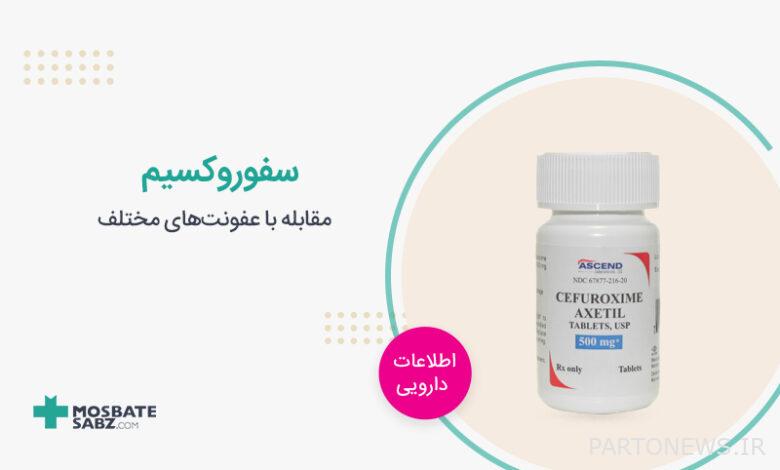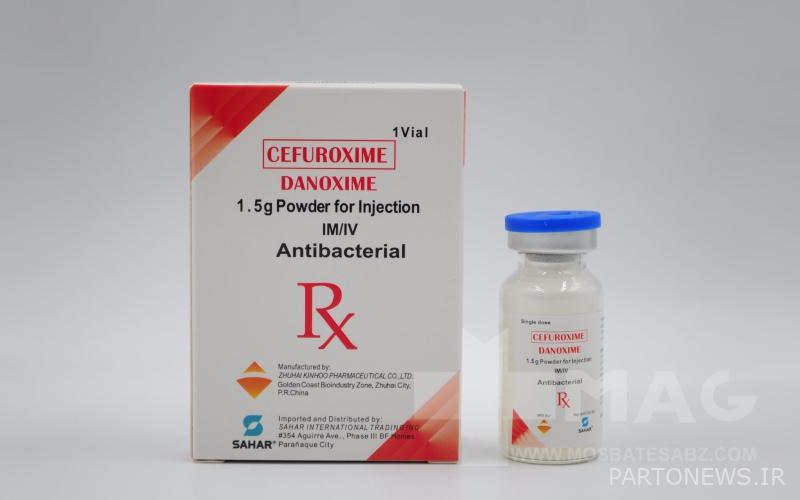Cefuroxime drug, benefits and side effects of Cefuroxime drug

Today, significant advances in the field of pharmaceuticals and medical research have led to the provision of useful and effective medicinal compounds. One of these new drugs that has been considered as an important tool in fighting infections is cefuroxime. Cefuroxime is an antibiotic from the group of cephalosporins, which was produced by a team of pharmacists and has the ability to fight against different types of bacteria. The uses and treatment of this drug are wide and the dosage should be determined by the doctor based on the type of disease. In the following, we will examine the uses, methods of administration, pharmaceutical forms and precautions of Cefuroxime.
Pharmaceutical forms of cefuroxime
- Oral suspension: 125 mg / 5 ml, 250 mg / 5 ml
- Powder for injection: 750 mg, 5 g, 7.5 g, 75 g, 225 g
- Tablets: 250 mg and 500 mg
Uses of cefuroxime tablets
Cefuroxime is used to treat a wide variety of bacterial infections. This drug is known as a cephalosporin antibiotic that works by stopping the growth of bacteria. This antibiotic only treats bacterial infections and does not work for viral infections (such as colds, flu). Using any antibiotic when it is not needed can make it ineffective for subsequent infections.
Uses of cefuroxime in adults
- Pharyngitis and tonsillitis
- Acute bacterial maxillary sinusitis
- Acute bacterial exacerbation of chronic bronchitis
- Bacterial infections secondary to acute bronchitis
- Uncomplicated pneumonia
- Uncomplicated skin/skin structure infections
- Uncomplicated urinary tract infections
- gonorrhea
- Primary Lyme disease
- Severe or complicated infections
Uses of cefuroxime in children
- Acute otitis media
- jaundice
- Pharyngitis and tonsillitis
- Severe or serious infections (off-label)
Pharmacological effects and mechanism of action of Cefuroxime drug
Mechanism of action Cefuroxime binds to penicillin-binding proteins and inhibits the final transpeptidation step of peptidoglycan synthesis, leading to cell wall death. It also resists degradation by beta-lactamase. The appropriate dose and the appropriate way of consumption are determined according to the patient’s condition, the severity of the infection and the sensitivity of the microorganism. The drug is widely distributed in body tissues and fluids, including cerebrospinal fluid (CSF). Finally, it is excreted through urine (66-100% as unchanged drug).
Dosage of Cefuroxime
Take cefuroxime by mouth as directed by your doctor, usually twice a day (every 12 hours). Take cefuroxime with food to increase absorption and reduce stomach upset. Swallow the tablet of this medicine completely and avoid crushing or chewing it. For best effect, take this antibiotic at equal times. To help you remember, take this medicine at the same times every day. Continue taking this medicine until the full prescribed amount is finished, even if symptoms disappear after a few days. Early discontinuation of the drug may lead to the return of the infection.
Time to take cefuroxime tablets in adults
- The dosage for pharyngitis and tonsillitis, acute bacterial exacerbation of chronic bronchitis and acute bacterial sinusitis of the upper jaw is 250 mg orally every 12 hours for 10 days. Also, the dosage of intravenous injection for the treatment of acute bacterial exacerbation of chronic bronchitis is 500 to 750 mg per 8 hours.
- For secondary bacterial infections of acute bronchitis, Cefuroxime is taken 250-500 mg orally every 12 hours for 5-10 days.
- For the treatment of uncomplicated pneumonia, the recommended dosage is 750 mg every 8 hours as an intravenous and intramuscular injection.
- The dosage for uncomplicated skin and skin structure infections is 250 to 500 mg orally every 12 hours for 10 days or 750 mg as an intravenous and intramuscular injection.
- The dosage for uncomplicated urinary tract infections is 125-250 mg orally every 12 hours for 7-10 days. It is also used for intravenous and intramuscular injection of 750 mg every 8 hours, which you should go to oral treatment as soon as clinically possible.
- To treat uncomplicated gonorrhea, take 1 gram orally 1 time or 1.5 mg as intramuscular injection once in 2 different places with 1 gram of probenecid orally.
- For the primary treatment of Lyme disease, 500 mg is prescribed orally every 12 hours for 20 days.
- Severe or complicated infections 5 grams as an intravenous and intramuscular injection in 8 hours, which may be administered in 6 hours in life-threatening situations.
How to use cefuroxime in children
- For the treatment of acute bacterial sinusitis of the maxilla in children from 3 months to 12 years old, 30 mg/kg divided every 12 hours is used orally. This dose for people over 12 years old is 250 mg every 12 hours for 10 days.
- For acute otitis media in children aged 3 months to 12 years, 30 mg/kg orally is used daily in 12 divided hours. Also, alternately, 75-150 mg/kg is used as an intravenous and intramuscular injection daily in 8 divided hours. This dose for people over 12 years old is 250 to 500 mg orally in 12 hours divided for 10 days.
- To treat jaundice in children from 3 months to 12 years old, 30 mg/kg is taken orally and divided every 12 hours for 10 days. It should be noted that it should not exceed 1000 mg per day or 75-100 mg/kg per day as an intravenous and intramuscular injection. This dosage amount for people over 12 years old is 250-500 mg orally in 12 divided days.
- Pharyngitis and tonsillitis in children from 3 months to 12 years, 30 mg/kg orally every 12 hours is used daily for 10 days. This dosage amount for people over 12 years old is 250 mg orally in 12 hours.
Precautions
Before taking cefuroxime, if you are allergic to it or to penicillins and other cephalosporin antibiotics (such as cephalexin), avoid taking it. This medicine may contain inactive ingredients that can cause allergic reactions or other problems. If you have medical records such as kidney disease, intestinal disease (colitis), liver disease, improper nutrition, history of sensitivity to antibiotics, etc., consult your doctor about the risks and complications. Cefuroxime may cause live bacterial vaccines (such as the typhoid vaccine) to not work as well. Before having any immunizations or vaccinations, tell your doctor.
- Long-term INR has been reported in patients with malnutrition, long-term treatment, and liver and kidney disease.
- Film-coated tablets and oral solution are not bioequivalent. Tablets should not be crushed or chewed, swallow the tablet whole so that it is well absorbed by your body.
- Use caution in patients with a history of colitis, renal failure, or a history of seizure disorders.
- Use with caution in patients with a history of penicillin allergy.
- Reduce dose by 50% if CrCl is 10-30 mL/min and by 75% if CrCl is less than 10 mL/min (high doses may cause CNS toxicity).
- Bacterial or fungal overgrowth of nonsusceptible organisms may occur with prolonged or repeated treatment.
- Taking cefuroxime has caused drowsiness and confusion in some patients. After taking, avoid doing things that require high alertness.
Cefuroxime contraindications
- Hypersensitivity to penicillin or other cephalosporins
Cefuroxime side effects
Decrease in hemoglobin or hematocrit, diarrhea, anemia, vaginitis, increased alkaline phosphatase, nausea and vomiting are some of the side effects of Cefuroxime. If any of these effects persist or worsen, tell your doctor or pharmacist right away. Most people who use this drug do not experience serious side effects. If serious side effects occur, including unusual fatigue and weakness, symptoms of liver problems (such as nausea and vomiting that does not stop, stomach and abdominal pain, yellowing of the eyes and skin, dark urine), symptoms of kidney problems (such as changes in the amount of urine), Symptoms of a new infection (such as a sore throat that does not go away, fever), easy bruising and bleeding, sudden movements, mental and behavioral changes (such as confusion), etc., consult a doctor.
- diarrhea
- Decreased hemoglobin or hematocrit
- Eosinophilia
- Nausea or vomiting
- vaginitis
- Transient increase in liver transaminases
- diaper rash
- Increased alkaline phosphatase
- Thrombophlebitis
- Increased lactate dehydrogenase
- Anemia

Cefuroxime drug interaction
- Class X Interactions (avoid): BST (intravesical), cholera vaccine, histamine H2 receptor antagonists, proton pump inhibitors
- Reducing the effects of drugs by cefuroxime: aminoglycosides, BTH (intravesical), BTH vaccine (immunogenic), cholera vaccine, lactobacillus and estriol, sodium picosulfate, typhoid vaccine
- Reducing the effects of cefuroxime by drugs: antacids, histamine H2 receptor antagonists, proton pump inhibitors
- Enhancement of drug effects by cefuroxime: aminoglycosides, vitamin K antagonists
- Interaction with food: bioavailability increases when taken with food, and serum levels of cefuroxime increase when taken with food or dairy products.
Cefuroxime consumption during pregnancy and breastfeeding
Available data from published epidemiologic studies, case series, and case reports over several decades in pregnant women have not established drug-related risks for birth defects, miscarriage, adverse maternal or fetal outcomes. Also, in animal studies in pregnant mice and rats administered orally at 14 and 9 times the maximum recommended human dose (MRHD), respectively, during organogenesis, there were no adverse developmental outcomes, based on body surface area.
The effect of Cefuroxime on breastfeeding
Based on some data describing several lactating women treated by intravenous, intramuscular and oral routes, it is excreted in human milk. The highest breast milk concentration described in lactating women occurred 8 hours after intramuscular administration of 750 mg. Allowing infant milk consumption of 150 ml/kg per day, the estimated dose for infants would be less than 1% of the adult dose. The developmental and health benefits of breastfeeding should be considered along with the mother’s clinical need for treatment and any possible side effects on the infant caused by medication or the mother’s underlying disease.
Cefuroxime storage conditions
Cefuroxime should be stored at room temperature and away from light and moisture. Also, all chemical and herbal medicines should be kept out of the reach of animals and children.
The last word of cefuroxime drug
In the conclusion of this article from the online pharmacy magazine, it can be stated that cefuroxime, as an antibiotic from the group of cephalosporins, plays an important role in the treatment of bacterial infections with broad and effective effects. With its unique mechanism of action, which is related to inhibiting the synthesis of the bacterial cell shell, this drug has been recognized as an effective option in the treatment of various infections, including respiratory, urinary, skin, etc.
Site source: Medscape
Written by Cefuroxime drug, benefits and side effects of Cefuroxime drug for the first time in Green Positive Pharmacy magazine. appeared.

